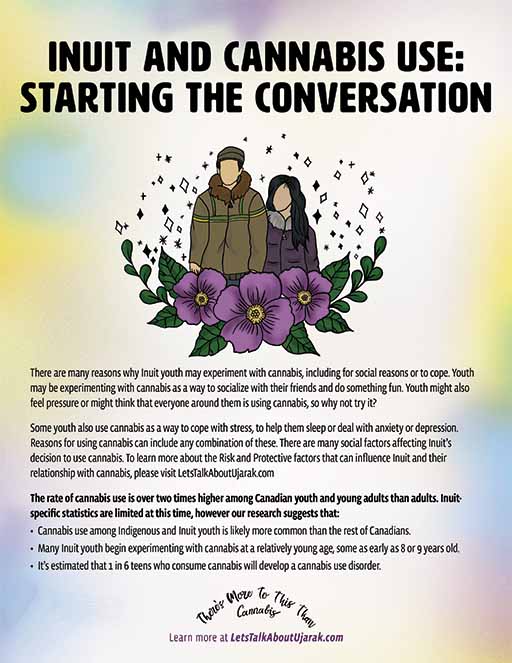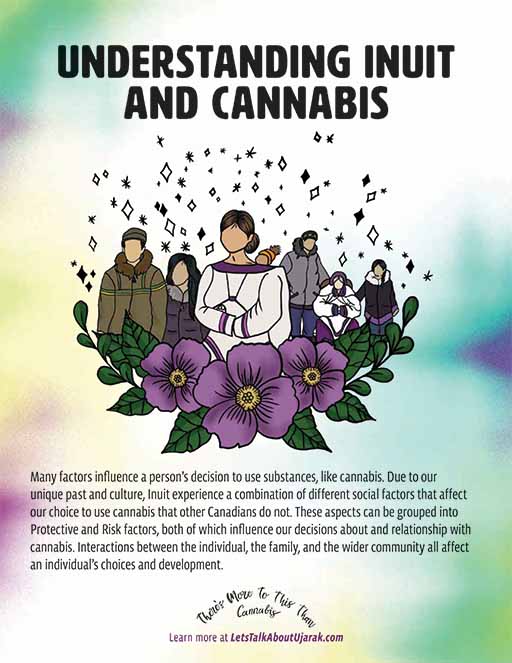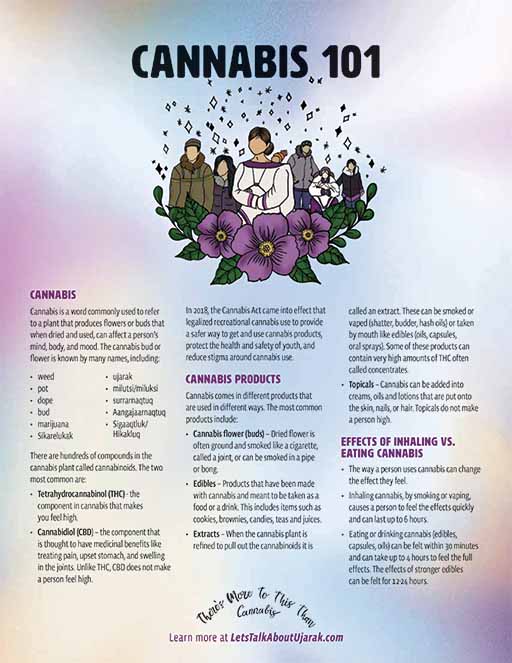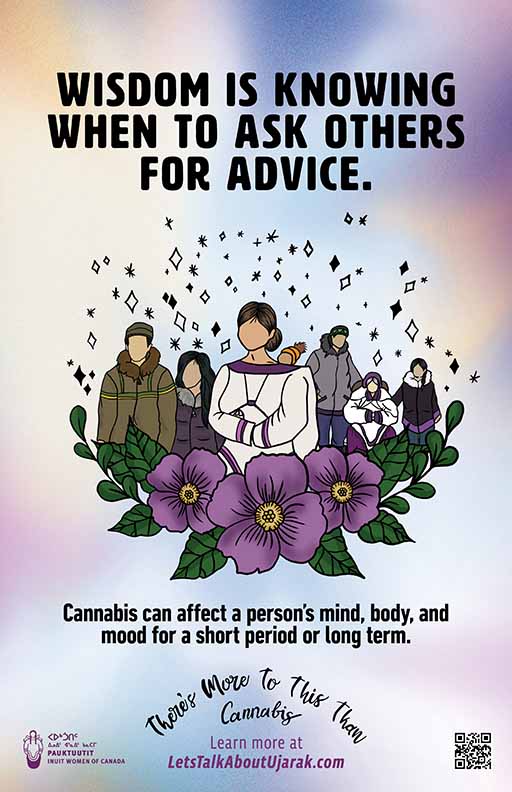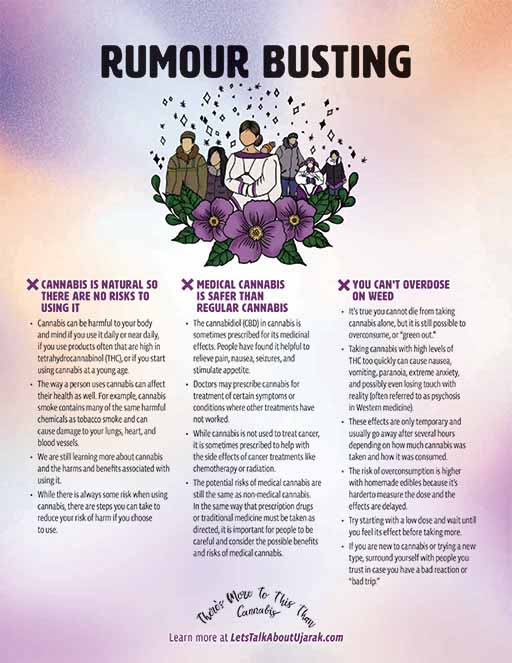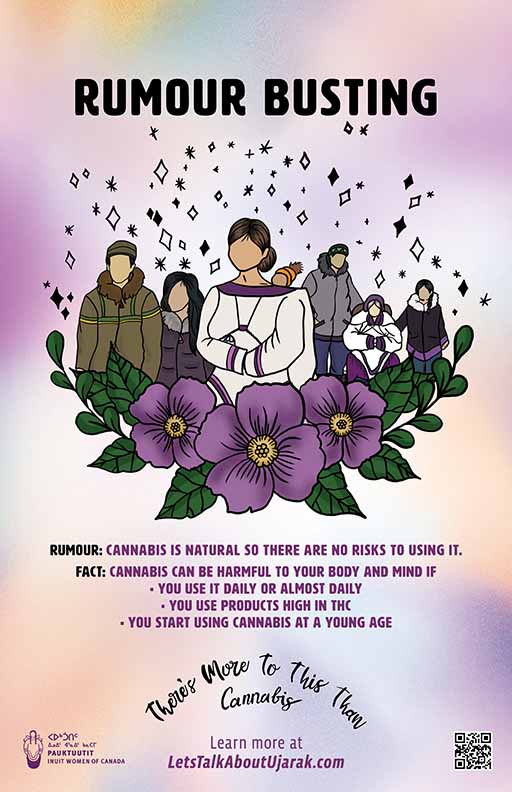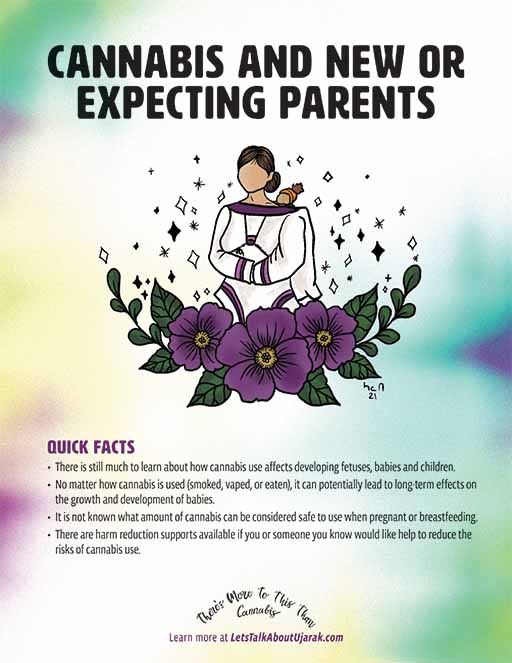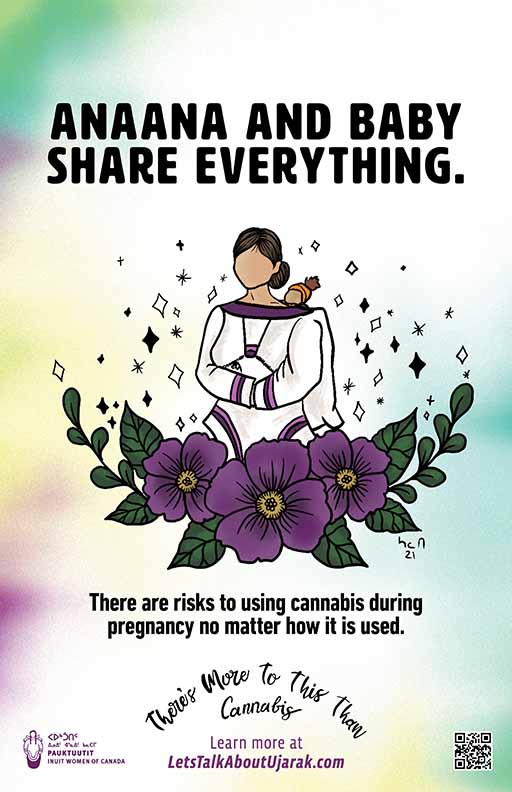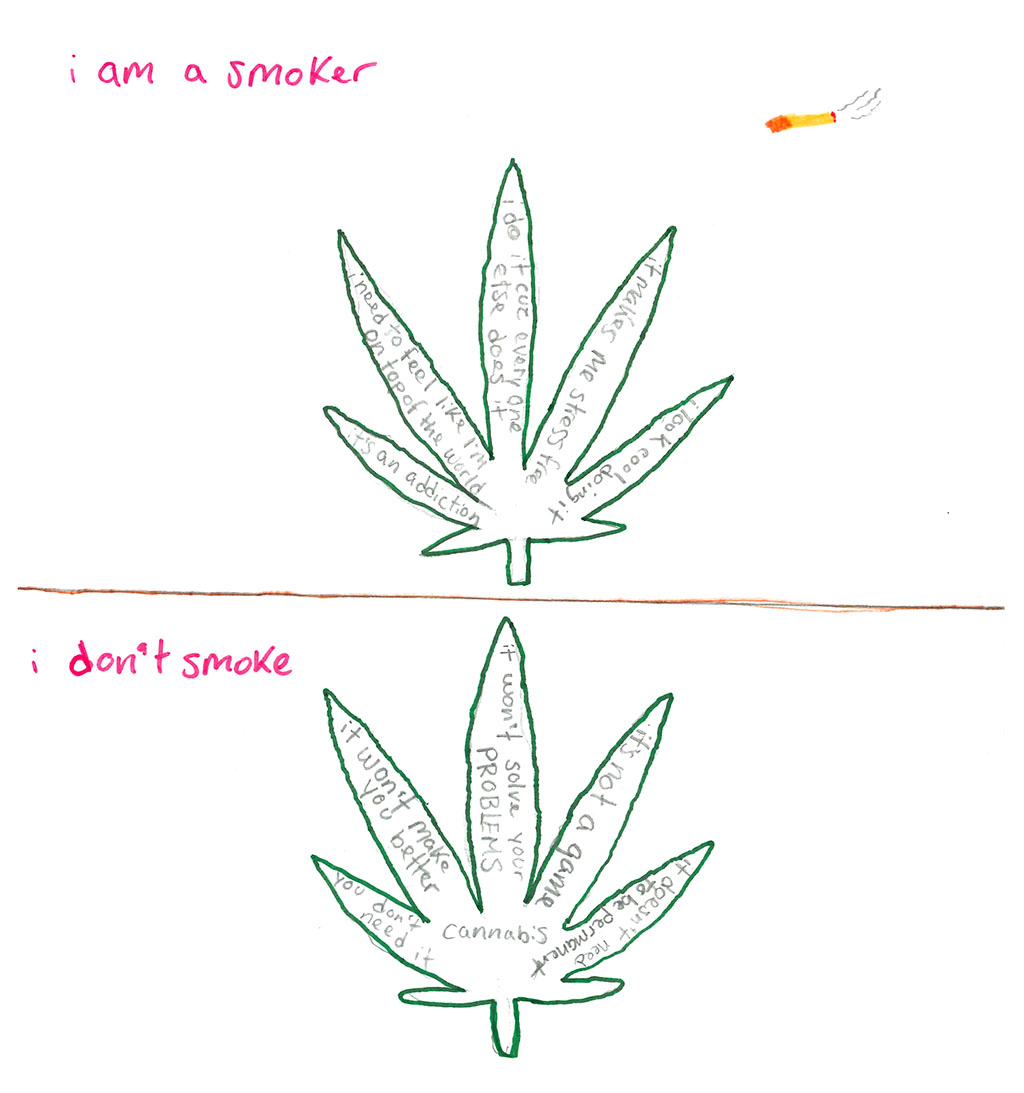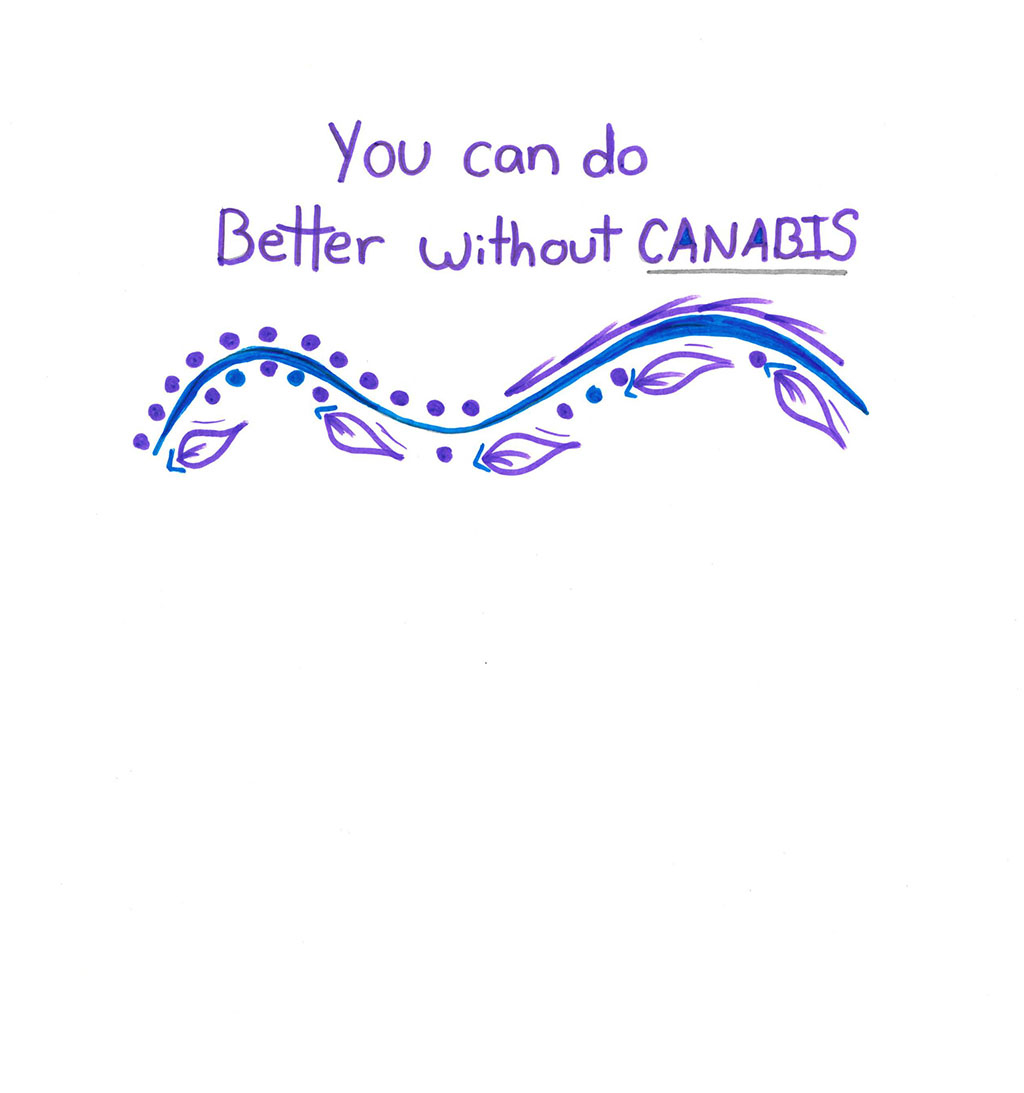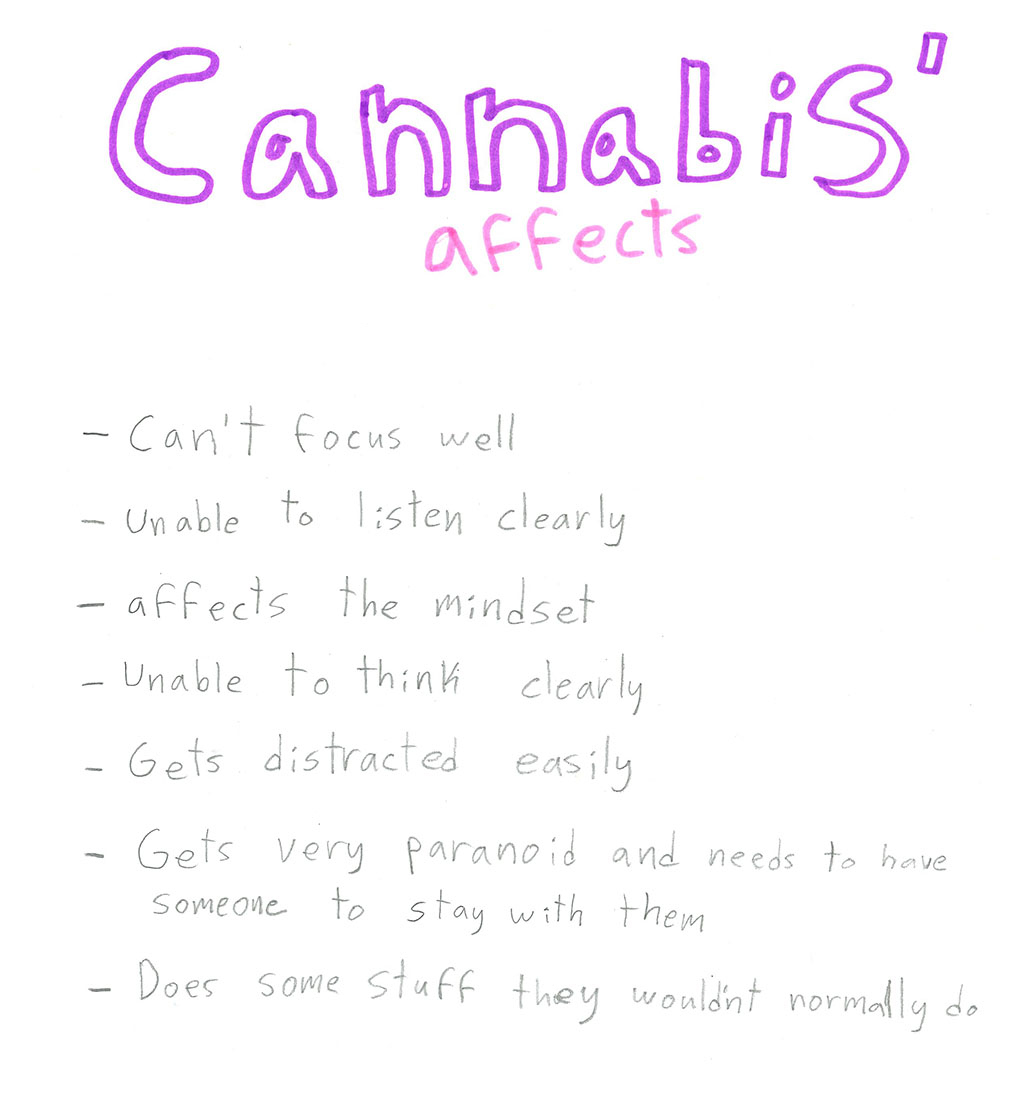
Let’s Talk about Ujarak: a Cannabis Harm Reduction Toolkit
Let’s Talk About Ujarak is a cannabis resource toolkit, guided by Inuit values and created to help Inuit increase their knowledge about cannabis use and how to reduce possible harms. The resources in this toolkit include factsheets, posters, a discussion guide, an assessment tool, and more – all developed from a trauma-informed and strength-based Inuit perspective.
Below you’ll find resources for new and expecting parents and youth, as well as general information that can help Inuit to make informed decisions about cannabis. These resources are also freely available to service providers and all members of the community.
Cannabis 101
Cannabis is a plant that produces flowers or buds that when used, can affect a person’s mind, body, and mood. Learn more about cannabis products, effects, and potential health impacts.
Information for New and Expecting Parents
There is still much to learn about how cannabis use affects developing fetuses, babies, and children. Find more information about how cannabis can interact with pregnancy, breastfeeding, and child development, as well as helpful harm reduction techniques.
Information for Youth
Because the bodies and brains of youth are still growing, youth are more at risk to the potential harms of cannabis. Learn more about how cannabis can affect youth as well as tips to reduce the risks of cannabis use.
Discussion Guides
Many factors influence Inuit decisions to use substances like cannabis, including our past experiences, current realities, and our culture. Learn more about these factors and how you can help open discussions around cannabis with your family or community.
Both are available in: Available in: English, Inuktitut, Inuinnaqtun, Inuttitut, Inuvialuktun, Nunavik
Reflecting on My Cannabis Use tool
The Reflecting on My Cannabis Use tool is a short, anonymous activity designed to help users reflect on their relationship with cannabis, understand any potential impacts on their life, and recommend helpful resources based on their decisions.
Please use the buttons on the bottom right corner to navigate through the tool.
Production of these resources has been made possible through a financial contribution from Health Canada. The views expressed herein do not necessarily represent the views of Health Canada.
Le présent ressources a été produit grâce à la contribution financière de Santé Canada. Les opinions exprimées ne représentent pas nécessairement celles de Santé Canada.
Cannabis 101
Cannabis is a plant that produces flowers or buds that when used, can affect a person’s mind, body, and mood. Learn more about the different kinds of cannabis products, their effects, and potential health impacts in the resources below.
Cannabis Products
Cannabis comes in different products that are used in different ways. The most common products include:
- Cannabis flower (buds) – Dried flower is often ground and smoked like a cigarette, called a joint, or can be smoked in a pipe or bong.
- Edibles – Products that have been made with cannabis and meant to be taken as a food or a drink. This includes items such as cookies, brownies, candies, teas and juices.
- Extracts – When the cannabis plant is refined to pull out the cannabinoids it is called an extract. These can be smoked or vaped (shatter, budder, hash oils) or taken by mouth like edibles (oils, capsules, oral sprays). Some of these products can contain very high amounts of THC often called concentrates.
- Topicals – Cannabis can be added into creams, oils and lotions that are put onto the skin, nails, or hair. Topicals do not make a person high.
Effects of Inhaling vs. Eating Cannabis
The way a person uses cannabis can change the effect they feel. Inhaling cannabis, by smoking or vaping, causes a person to feel the effects quickly and can last up to 6 hours. Eating or drinking cannabis (edibles, capsules, oils) can be felt within 30 minutes and can take up to 4 hours to feel the full effects. The effects of stronger edibles can be felt for 12-24 hours.
Short-term effects – pleasant
The effects of cannabis can change based on:
- The age of the person
- The amount used
- How often it is used
- The way it is taken
- Where it is taken (e.g. at home)
The pleasant short-term effects can include:
- Euphoria or a sense of well-being
- Relaxation
- Heightened sense of sight, taste, smell, and sound
- Focus and creativity
- Increased self-awareness
- Increased appetite
- Real or perceived pain relief
Other effects – unpleasant
Cannabis can sometimes cause effects that are unpleasant or unwanted.
Effects on the brain:
- Sleepiness
- Confusion
- Difficulty with memory or concentration
- Slower reactions
- Anxiety
- Distorted sense of time
- Seeing and hearing things that are not real
Possible effects on the body:
- Damage to the blood vessels, lungs and heart from smoking cannabis
- Changes in blood pressure, which can cause fainting or potential problems for people with heart conditions
Cannabis Overconsumption
Overconsumption refers to too much of a substance taken at one time. While overconsumption of cannabis cannot kill you, using too much at a time can result in an unpleasant experience often referred to as “greening out” which can include:
- Severe anxiety
- Paranoia
- Fear or panic attack
- Severe nausea
- Vomiting These effects are temporary and will go away after the cannabis has worn off.
Possible Long-term effects of cannabis
Long-term effects of cannabis can occur with use over time and can impact:
- Brain Development
Long term and/ or heavy Cannabis use can affect a person’s memory, concentration, and ability to make decisions. - Dependency
It is possible to become dependent on cannabis. This is where a person can experience irritability, low appetite, and mood swings if they go without using cannabis. The risk of developing a dependency increases when cannabis is used with other addictive substances such as tobacco. - Respiratory Problems
Smoking cannabis has similar risks to smoking tobacco. Health risks can include breathing problems, a cough that will not go away, and mucus build-up. These risks increase in cold temperatures and among those with existing respiratory challenges like Tuberculosis. - Mental Health
While some people find cannabis helps them with symptoms of mental illness or to cope with trauma, long term and heavy cannabis use has also been linked to depression, anxiety, and cannabis use disorder among some users.
If a person or their family has a history of mental illness, trauma, or schizophrenia, heavy cannabis use can increase the possibility of triggering an episode. This is where a person loses contact with reality and hears and sees things that are not real. These are more likely to occur if a person:
- Starts using cannabis at an early age
- Uses cannabis frequently over a long period of time (daily or near daily use)
- Uses concentrated cannabis products that are high in THC content (higher than 15% THC)
- Some people who use cannabis may see, hear, feel, or experience things that differ from other’s perception of reality. In Western medicine this experience is referred to as psychosis. This experience can be negative and unwanted or positive and spiritual depending on the intent of the user.
Factsheets and Posters
Cannabis 101 Fact Sheet available in:
English
Inuktitut
Inuinnaqtun
Inuttitut
Inuvialuktun
Nunavik
Cannabis 101 Poster
available in:
English
Inuktitut
Inuinnaqtun
Inuttitut
Inuvialuktun
Nunavik
Rumour Busting Fact Sheet available in:
English
Inuktitut
Inuinnaqtun
Inuttitut
Inuvialuktun
Nunavik
Rumour Busting Poster
available in:
English
Inuktitut
Inuinnaqtun
Inuttitut
Inuvialuktun
Nunavik
Information for New and Expecting Parents
There is still much to learn about how cannabis use affects developing fetuses, babies, and children. No matter how cannabis is used, it can potentially lead to long-term effects on the growth and development of babies. While it is not known what amount of cannabis can be considered safe to use when pregnant or breastfeeding, there are harm reduction supports available if you or someone you know would like help to reduce the risks of cannabis use.
Cannabis & Pregnancy
- Cannabis contains over 400 compounds which can pass from mother to baby.
- When a fetus is exposed to cannabis, the potential harms at birth can include a smaller baby with a low birth weight.
- While some mothers may choose to use cannabis to help with morning sickness (nausea), your Elder, health care provider, or community midwife can recommend other trusted options for coping with discomfort during pregnancy.
Cannabis & Child Development
There is some research suggesting that cannabis use during pregnancy can change the way a child grows and acts later in life. Potential behaviour and brain development challenges for children can include:
- Poor attention span
- Hyperactivity
- Poor memory
- Learning problems at school
Cannabis & Breastfeeding
- Breastfeeding is the best and most affordable way to feed your baby what it needs to grow and be healthy.
- Tetrahydrocannabinol (THC) from cannabis can pass into mothers’ breastmilk and be shared with the baby.
- Babies who are exposed to THC through breastmilk may become drowsy or have a hard time latching onto the breast.
Reducing the Risk - Harm reduction tips
- If you are having trouble becoming cannabis-free, try reducing the amount you use.
- Reduce how often you use. If you are using daily or near daily, try limiting when you use to certain days of the week.
- Try cannabis products that are lower in THC and higher in cannabidiol (CBD), which is the medicinal compound.
- Switch to edible cannabis products to avoid cannabis smoke. Cannabis smoke reduces the amount of oxygen going to the fetus and affects its development. However, keep in mind cannabis that is eaten can stay in your system longer.
- Use cannabis on its own rather than with other substances like tobacco, alcohol, or cocaine.
- If possible, try to avoid rooms where people are smoking cannabis or tobacco to avoid second-hand smoke.
- If smoking or vaping cannabis, avoid doing so near children or while carrying a child in an amauti.
- Clearly label and securely store any cannabis products in the home.
Being a Supportive Partner or Family Member
- Making a cannabis-free zone around pregnant and breastfeeding women can help reduce the temptation to use and prevent exposure to second hand smoke.
- Keep cannabis products and accessories (ash trays, lighters, pipes) out of sight as these can be triggers for use and pose dangers to young children in the home.
- Try to avoid smoking cannabis in the home while others are present (even out of a window), or on the porch near any open windows.
- Offer to go cannabis-free with your partner to help create a supportive and healthy environment.
- Focus on providing support in an open minded and non-judgemental way.
- Keep track of the money saved by cutting back or going cannabis-free, consider how this money could be put towards other uses such as a sewing machine or hunting supplies.
- Try to manage stress in the home by creating positive routines including a healthy diet and activities.
Factsheets and Posters
Fact Sheet available in:
English
Inuktitut
Inuinnaqtun
Inuttitut
Inuvialuktun
Nunavik
Discussion Guide available in:
English
Inuktitut
Inuinnaqtun
Inuttitut
Inuvialuktun
Nunavik
Poster available in:
English
Inuktitut
Inuinnaqtun
Inuttitut
Inuvialuktun
Nunavik
Youth and Cannabis Use
Because the bodies and brains of youth are still growing, youth are more at risk to the potential harms of cannabis. Learn more about how cannabis can affect youth as well as tips to reduce the risks of cannabis use in the resources below.
Short Term Effects
- Some people feel weed helps them focus, but weed can also make it harder to think clearly, pay attention in class, make decisions, and react quickly.
- Using weed daily or almost everyday can make it harder to learn and remember things over time.
- The effects of weed can be unpredictable. While it can help some people feel relaxed, others may feel anxious, sad, or scared, especially if using products high in tetrahydrocannabinol (THC).
Long Term Effects
- Smoking weed can affect your body like smoking tobacco. It can damage your lungs, cause breathing problems or a cough that does not go away.
- Using weed daily or near daily can lead to a dependency on weed.
- Just like quitting tobacco, there can be unpleasant symptoms when you reduce or quit weed, like feeling short tempered, anxious, or experiencing changes in appetite and trouble sleeping.
Other Impacts of Cannabis Use
-
Weed can affect your physical health including your endurance for hockey, soccer, and other sports.
-
Ujarak is expensive! Think of all of the other things you could buy with that money.
-
Buying from unlicensed sellers comes with the risk of getting weed that is poor quality or contains mould, chemical pesticides, or other dangerous drugs.
-
Heavy use of weed may cause you to lose interest in hobbies and relationships, which can cause problems with family and friends.
-
Similar to alcohol, workplaces do not allow working while high and you could face punishment, lose your job, or be involved in an accident.
Mental Health
While some people may use weed to relax or relieve pain, frequent use ofweed at an early age carries some risks to mental health. Heavy cannabis use can increase the risk of developing mental health challenges like schizophrenia. The risk is greatest among individuals with:
- a family history of mental illness
- those who frequently use products containing high amounts of THC
- those who begin use early in life (before the age of 16)
- those with past traumatic experiences
- Problematic cannabis use and cannabis use disorder are more common among individuals with mood and anxiety disorders.
Driving While High
- Weed can cause you to be clumsy and react slowly. This makes it dangerous for you to drive a vehicle, quad, skidoo, boat, or truck while high.
- It is best to wait a minimum of 4-6 hours before driving after inhaling weed, but it’s important to remember that the way weed is taken, the amount used, and even the differences from person to person can all extend this time. If you don’t feel right, don’t drive.
- Driving while high makes you 2 times more likely to get into an accident, which can cause serious injury or death.
- It is illegal to drive high in Canada. If you are caught driving while impaired, you may get a penalty like:
-
- Having to pay a fine
- Having your drivers licence taken away
-
Reducing the Risk – Harm Reduction tips
- It is best to try to wait to use weed until you are about 25 years old because your brain is still developing until then.
- Space out the time of the week when you use weed so you are not using daily or near-daily. Try to use it once a week or less.
- Limiting your use of weed to non-school days can help with focusing in school.
- Try to choose products that have lower amounts of THC like 15% or lower. High THC concentrated products such as some forms of shatter, dabs, or wax, have more risks for your physical and mental health.
- Smoking is the least healthy way of using cannabis. Consider edibles as a less harmful choice, however remember that some edibles can be very potent and have longer lasting effects than smoking.
- Try to avoid using cannabis with other drugs. Mixing cannabis with other drugs can lead to unexpected and dangerous effects:
-
- Using cannabis with alcohol can heighten the effects of both drugs and increase the risk for over-intoxication.
- Using weed with tobacco increases your risk of dependency and exposes you to more harmful chemicals, compared to using either on its own.
- Using weed with other drugs can have unpredictable effects or lead to potential overdose situations.
-
- Plan a safe way home or stay at a friend’s house if you are going to a party with cannabis. Getting into a vehicle with a high driver risks everybody’s safety.
- Do you feel safe where you are choosing to use cannabis and the people you are with? Choose to use with people you trust and places that are safe.
- Avoid sharing bongs or joints to reduce the risk of spreading germs or tuberculosis.
- Make sure to safely store any cannabis products. Keep weed out of reach from young kids and pets.
Let’s Talk About Ujarak Youth Poster Contest
Inuit youth can be exposed to cannabis use at ages as young as 9 years old, so it is important to start conversations about cannabis early! Pauktuutit is visiting schools across Inuit Nunangat to deliver workshops about cannabis use, its effects, and how to reduce harms.
Following the workshop in Nunavik, youth had an opportunity to participate in a contest to create posters for other Inuit youth, to share information about risks of cannabis use and ways to reduce harms.
